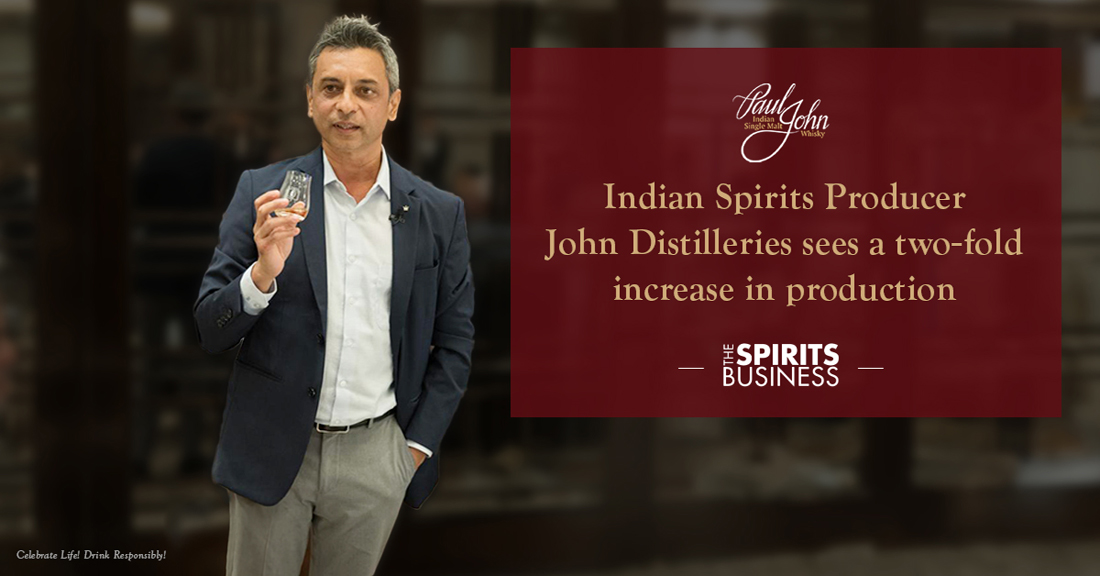
Rupert Hohwieler on August 28 2024
Paul John doubles production
Indian spirits producer John Distilleries has doubled production of its single malt whisky Paul John and is planning to build a new distillery for the brand after 2030.
This year, Goa-based Paul John expanded its production capabilities from 1.5 million to 3m litres of alcohol annually and its main focus for the next three years is to increase the number of barrels, the company's master distiller Michael D'Souza told The Spirits Business.
He continued: "Currently, we have 40,000 barrels. Our target is to reach 75 to 80,000 barrels. That would be the plan for the Goa operation. Post-2030, if everything goes well, we would have a new distillery somewhere in the southern part of India. That is our plan as of now and hopefully it should work."
The brand features 12 expressions in its lineup and produces two different liquids; non peated and peated, from Indian malted barley, yeast and water. There's entry-level, flagships and select cask releases in the portfolio.
For the future, D'Souza disclosed that he is looking to launch a rum-finished whisky. He said: "We have a collaboration with a rum distillery in Barbados. So we have got their casks and I have transferred some of the best liquid, from five to six years old, into that. It's ageing and hopefully in a few months, or years time, we should be ready for launch."
D'Souza also notes that the brand isn't able to age and experiment in the same way that countries such as Scotland can and that he wouldn't make comparisons.
Paul John is produced in Goa on the western coast of India, where the weather is very tropical and there is minimal variation in temperature throughout the year. There is no winter, summer is hot and humid and for four months of the year it rains. This, he notes, means the whisky extraction is four times higher compared to colder regions and that the liquid comes of age earlier.
“We lose a substantial amount of alcohol due to angel's share (close to 8%). The way maturation happens in other Indian distilleries such as Amrut and Rampur is entirely different. In those places, the ABV increases year on year due to the dry climatic conditions, whereas for us, being in Goa, it goes down because of the humidity.
"We don't have much time to keep the whisky in the barrels because the liquid changes so fast due to the conditions. For example if it is cooler you have a lot of time to do the innovations, to understand. When you do some kind of innovation or experiment, you need enough time to understand what is happening inside the cask, so we are taking small steps, but proper ones."
"There's a different reaction and different angel's share where we are, compared to the north and the south, so we are able to make unique tropical whisky because from our new make spirit the ABV is around 63% and it drops down to 58% ABV after five years. If I want to bottle at 46%, I need much less water."
Interest for Paul John overseas
A penchant for brown spirits, particularly imported bottles of single malt Scotch, have seen the IWSR forecast India's alcohol market to grow sixfold by 2027. India fell from the number-one export market for Scotch by volume in 2022 to its second-biggest last year.
Although whisky is not new to India, single malts are, especially homemade ones - as many Indians, such as D'Souza himself, grew up on blended whiskies due to their more approachable, less expensive nature.
D'Souza credits the brand for changing the perception of Indian whisky, which is in the ascendancy in terms of demand.
"No doubt before Paul John, even though Amrut was already in the market, nobody had a good perception about Indian whiskies for various reasons," he said.
"Unfortunately in India, we have something called IMFL, which is Indian-made [foreign liquor]. Made out of extra neutral alcohol, wherein we are allowed to add colour, artificial flavours and create different types of alcohol products, including whiskey, brandy, rum and gin. So the people always thought even single malt in India was made out of molasses. Then along came Paul John and slowly the perception changed. Today the entire world is receiving Indian whiskies very well."
There is still a way to go in its home market though.
Paul John is foremost being pushed overseas, as international single malt brands are still the first choice for Indians from home. The US is the brand's biggest market (Sazerac has an equity stake in John Distilleries after all), and it's also doing well in Europe - specifically Germany, France, and Poland - and then Japan. The UK is a tougher nut to crack as it's not easy for Paul John to "compete with the biggest brands in the world", D'Souza admits.
On the spirits market in India, he noted: “In India everything sells. If you want to make volumes, India and China - these are the markets. But you cannot build your brand. Today buying capacity has increased, people spend a lot of money to buy premium liquid. But unfortunately, I would say when it comes to Indian consumers we are 15 years behind the Western world.
“Today someone would be happy to buy Johnnie Walker Blue Label and pay a lot of money. Add cola and drink it. For me, drinking the brand is more important than appreciating the liquid itself. What we do is, we normally promote our launch, our new products abroad first to gain traction. Then we slowly release the same thing in India.
"Most of the good stuff, regardless of who's launching it, you will find the best stuff selling abroad."
To read original news, Click Here.

